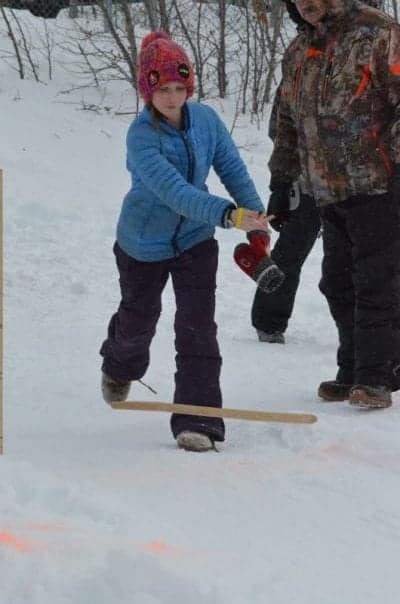
Gillian Furniss of William McDonald School lets fly during the snowsnake event as part of the Traditional Games Championships at William McDonald Field on Feb. 25.
Dene games is something we're used to seeing a lot of in Yellowknife. Each year, the Aboriginal Sports Circle of the NWT organizes the Traditional Games Championships, which includes a Dene games component.
We honour the sporting traditions of the Circumpolar North by playing games that the Inuit and Dene have played for generations.
A way to show off strength, sharpen on-the-land survival skills and bring people together, Dene games are also played today to celebrate and share culture. Next month, when athletes descend upon Fort Smith and Hay River in the South Slave, some of them will be competing in finger pull, snow snake, and stick pull; and the team sports of pole push and handgames.
Handgames
If you’ve spent some time in the NWT or Yukon, you’ve likely watched handgames being played in the community. Sometimes called “stick gambling,” the aim of the eight-person game (two teams of four) to bring all 12 of the game sticks over to your side by concealing your own small objects in your hands and guessing where the other team has hidden theirs. The hand signals used in the game vary by community but at the AWG, we’ll be following the four calls set out by the AWG International Committee. One match consists of winning two rounds of play (all 24 sticks).
Pole push
The second team sport is pole push. Somewhat self-explanatory, two teams standing on opposite sides of a wooden pole try to push each other out of a marked boundary, both teams holding the pole no higher than their shoulders and no lower than their hips. Depending on the length of the pole, teams can fit up to 25 athletes on each team. During the AWG, contingents will be sending four players each. The best of three “pushes” wins.
Finger pull
Finger pull is an Alaskan game of strength and endurance, where two athletes sit facing each other and after bracing their arms and legs, they lock their middle fingers between the first and second knuckle. One player is designated “offensive,” while the other is “defensive.” When given a signal, the offensive competitor begins to pull, slowly and steadily, with the aim of causing the defensive athlete’s arm to move or their finger to straighten. The best of three “pulls” wins.
Snow snake
Snow snake is an outdoor game, where athletes throw a thin spear underhand down packed snow, often starting from a running position. The person to slide the snow snake the furthest in this game of power and accuracy wins. In the past, the snow snake was a used to hunt moose and caribou that were lying down on the ice.
Stick pull
Lastly, we have stick pull, a game where one player from each team stands next to the other, each athlete holding one end of a greased stick while staring ahead with their knees straight. On the start signal, the athletes try to pull the stick straight out of their opponent’s hand – no twisting or bending is allowed. The game helps athletes develop grip strength, which is important for all sorts of on-the-land skills. Like in finger pull, the best of three “pulls” wins.
